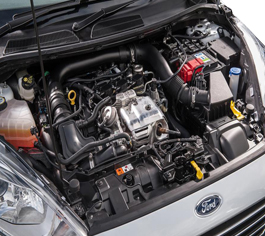The Role of a Quality Ford Fiesta Engine in Vehicle Performance
The Role of a Quality Ford Fiesta Engine in Vehicle Performance
Blog Article
Discovering the Evolution of Engines: From Classic Styles to Modern Marvels
From the preliminary vapor engines that powered the Industrial Change to the development of internal burning engines that transformed flexibility, each stage has added to better performance and ability. As we check out these landmarks, one need to take into consideration exactly how the future of engine layout might unravel, testing our understandings of power and efficiency.
The Birth of Engine Modern Technology
The arrival of engine innovation marked an essential minute in human technology, changing energy conversion and transportation. The earliest engines emerged from the demand to harness mechanical power for practical usage, leading to the advancement of gadgets that transformed numerous energy kinds into movement (ford fiesta engine).
The growth of the internal burning engine and the invention of the heavy steam engine militarized a profound change in commercial capacities. These engines not only boosted performance but likewise increased the range of human movement, allowing unmatched transportation possibilities. The early prototypes laid the groundwork for the mechanized world, facilitating the rise of industries and reshaping societal structures.
As engine styles advanced, they advanced and included innovative materials design principles, leading the way for contemporary growths - ford fiesta engine. The birth of engine modern technology ignited a relentless pursuit of effectiveness and power, establishing the stage for the vibrant development of transportation and industrial machinery that would adhere to
Vapor Engines and Their Impact

The steam engine's impact was especially apparent in the transport field (ford fiesta engine). Steam-powered locomotives helped with the fast movement of items and people across large distances, efficiently reducing the geographical obstacles that had actually previously hindered profession and communication. Steamships transformed marine traveling, permitting for quicker and extra dependable crossings of seas and rivers.
In sector, steam engines powered factories, enabling mass manufacturing and the surge of city facilities as hubs of financial activity. Vapor innovation promoted advancements in engineering and production procedures, laying the groundwork for future advancements in engine style.
The Rise of Internal Burning
Often outweighing heavy steam power, the surge of interior burning engines marked a transformative shift in transportation and industry throughout the late 19th and early 20th centuries. The advancement of these engines, characterized by their capacity to burn gas within the engine itself, made it possible for greater efficiency and power contrasted to traditional steam engines. Introducing inventors such as Nikolaus Otto and Rudolf Diesel played crucial duties in developing engine layouts, resulting in extensive fostering in my review here vehicles, watercrafts, and commercial machinery.
The inner combustion engine's portable size and relatively light-weight nature helped with the emergence of individual cars, revolutionizing specific movement and improving metropolitan landscapes. By enabling faster traveling and the efficient transportation of goods, these engines militarized economic growth and promoted globalization. The versatility of fuel alternatives, including fuel and diesel, even more enhanced their appeal, permitting diverse applications throughout different fields.
In spite of the ecological issues that would certainly later occur, the first appeal of inner combustion modern technology lay in its transformative capacity. As culture embraced this advancement, the foundation was laid for contemporary transport systems, developing internal combustion engines as a keystone of commercial development and everyday life throughout the 20th century.
Advancements in Engine Efficiency
As internal burning engines became important to transport and industry, the emphasis moved in the direction of enhancing their effectiveness to fulfill expanding needs for performance and sustainability. Developments in engine style, product scientific research, and modern technology have substantially added to this advancement.
One major development is the advancement of turbocharging, which enables for boosted air consumption, causing even more full gas burning and boosted power result without increasing the size of engine dimension. In addition, variable valve timing systems have actually been implemented to optimize engine performance across numerous RPM arrays, therefore enhancing fuel efficiency.
The utilization of sophisticated fuel injection technologies, such as straight shot, has likewise played an essential duty. This approach allows for more exact control over the fuel-air combination, advertising much better combustion and reducing emissions. Light-weight products, including light weight aluminum and composite elements, have been taken on to decrease overall engine weight, leading to boosted effectiveness.
These improvements reflect a broader fad within the vehicle industry, where the harmony between engineering innovation and ecological factors to consider drives the recurring pursuit for higher effectiveness in interior combustion engines. Therefore, contemporary engines are now much more powerful, cleaner, and efficient than in the past, leading the way for a much more lasting future in transportation.
The Change to Electric Power
With growing problems over environmental influence and fossil fuel dependence, the automotive sector is experiencing a significant change towards electrical power. This change is driven by a combination of technical developments, governing pressures, and altering customer preferences. Electric lorries (EVs) provide an engaging choice to standard inner combustion engines, boasting minimized greenhouse gas exhausts and lower operating expenses.
The surge of battery technology has been a game changer, with lithium-ion batteries ending up being more reliable and affordable. Improved power density and faster charging capabilities have made EVs a lot more practical for day-to-day use. In addition, governments worldwide are executing rewards and setting ambitious targets my website for eliminating fossil gas lorries, therefore accelerating the fostering of electrical power.
As charging infrastructure expands and battery modern technology proceeds to enhance, the change to electric power is positioned to improve the auto landscape, promoting sustainability and advancement in the years to come. The future of transport is electric, and the energy is undeniable.
Verdict
The development of engine modern technology represents a substantial trajectory of development that has actually greatly influenced transportation and sector. From the foundational vapor engines to the transformative internal burning engines, each development has added to enhanced flexibility and economic growth.

Report this page